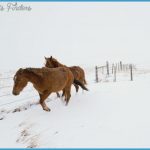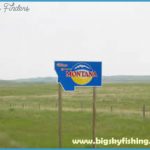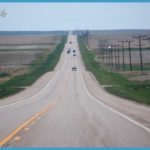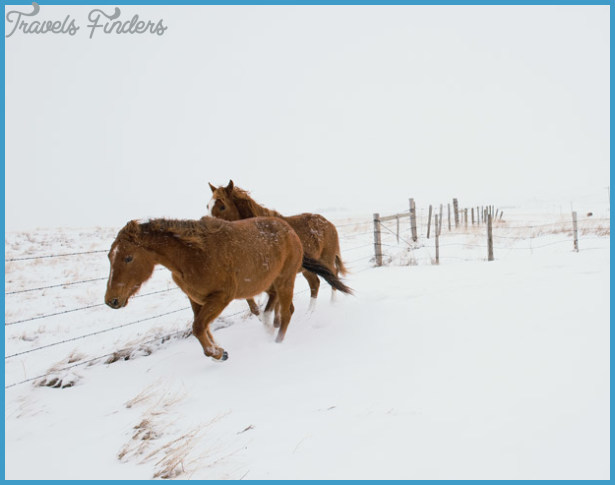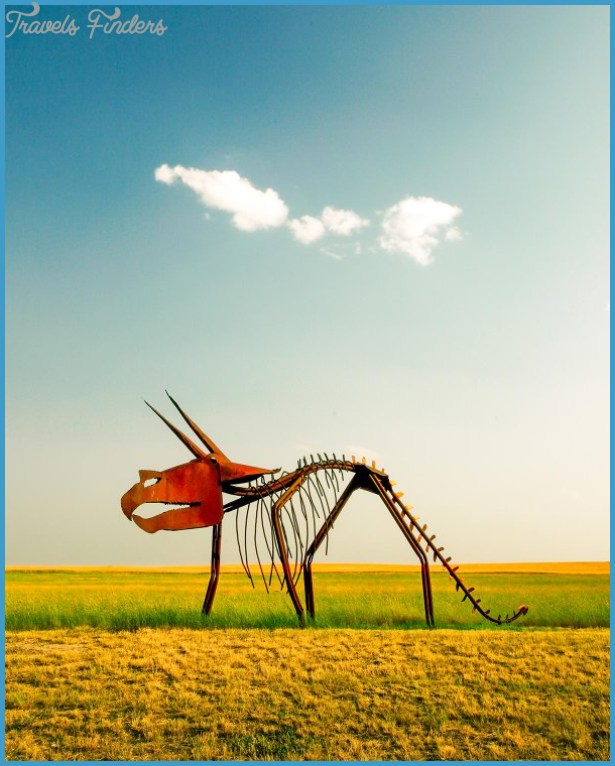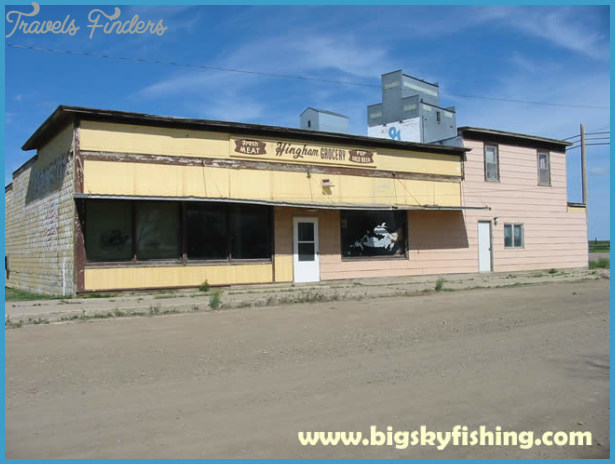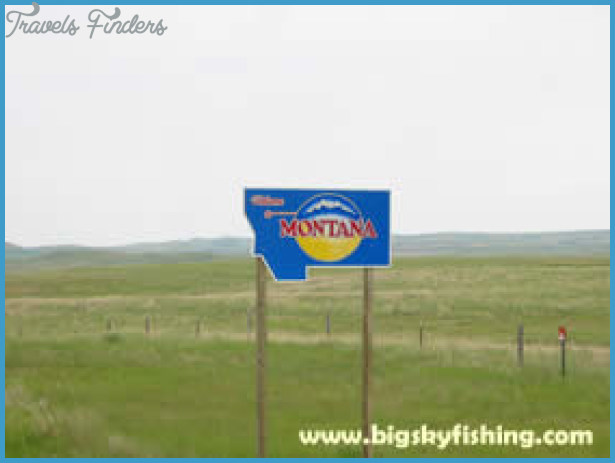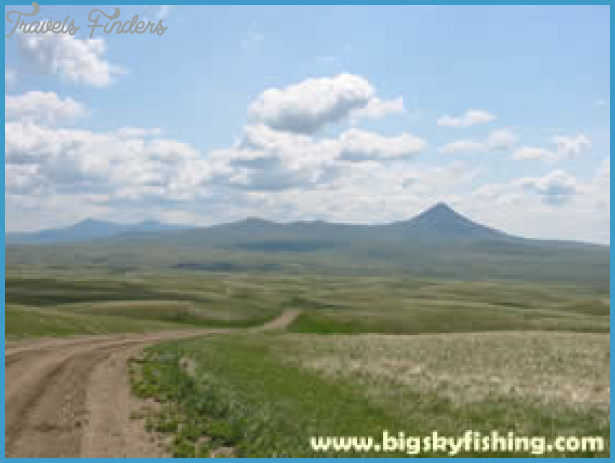The Hi-Line GLASGOW TO SHELBY
ESTIMATED LENGTH: 260 miles estimated time: 5 hours to 3 days
Highlights: Dinosaur trail museums and field stations, Sleeping Buffalo Hot Springs, Sleeping Buffalo Rock, Bowdoin National Wildlife Refuge, Blaine County Wildlife Museum, Bear Paw Battlefield, Havre Beneath the Streets, Havre Railroad Museum, Fort Assinniboine, H. Earl Clack Museum, Wahkpa Chu’gn Buffalo Jump, Marias Museum of History & Art
Getting there: We recommend starting your Hi-Line adventure in Glasgow, in part because you will end up at Glacier National Park’s doorstep. You can include the Big Sky Backcountry Byway tour by leaving I-94 at Terry and continuing north to Wolf Point on MT 263, MT 200, and MT 13. From Wolf Point, it’s 47 miles west on US 2 to Glasgow. The west end of the Hi-Line is accessed by taking I-15 north at Butte and continuing through Helena and Great Falls to the US 2 East exit at Shelby. In addition, Amtrak parallels US 2 on the busy Burlington Northern Santa Fe route, with twice-daily stops one each direction in Glasgow, Malta, Havre, and Shelby. Glasgow is served by Great Lakes Airlines with flights from Wolf Point, Miles City, Billings, and Denver; Havre has Great Lakes flights to and from Lewistown, Billings, and Denver.
In Montana, where rugged individualism is almost as much a part of the human experience as breathing, even the most leathery residents tip their hats to the weather-toughened residents of the Hi-Line. A hardy constitution is required to carve a life and livelihood out of the wind-sculpted prairies shouldering the turbid Milk River just south of the Canadian border.
This was the last area of Montana to be settled and the first to be deserted. At first glance, there is little here but cattle, barbed wire, and lonely whistle-stop grain elevators to blunt the winds from the north as they roar unchallenged across the prairies from the Arctic and Canada. If it weren’t for the distant island mountain ranges rising like protective shadows on the horizon, you’d think you’d taken a wrong turn and landed in Nebraska. The reward for residents’ fortitude is hot summers amid cottonwood trees in oasis towns 8 to 10 miles apart, lazy days angling for warm-water fish, and evening breezes that may or may not fend off the prodigious mosquitoes. The towns, all but a handful with fewer than 1,000 residents, are some of Montana’s loneliest. By the time they sprang up as sidings along the Great Northern Railway (now Burlington Northern Santa Fe), creativity for new names of water stations was tapped out. So most monikers on the Hi-Line came from an office at the Great Northern headquarters in St. Paul, Minnesota, where a railroad employee was blindfolded, a globe was spun, and a finger was randomly aimed. The result was such incongruous post office addresses as Glasgow and Inverness (Scotland), Zurich (Switzerland), Malta (island in the Mediterranean Sea), Saco (Maine), Hinsdale (Illinois), Harlem (New York), Fresno (California), Dunkirk (France), and Joplin (Missouri). Folks in Chinook did localize theirs they named their comfortable little town for the winter winds that blow off the Rockies with such ferocity that a minus 20-degree day can turn to plus-30 degrees in a few hours, or vice versa.
The Hi-Line is so-called because the railroad and then US 2 cut a gradually rising straight east-west line that begins at the North Dakota border and slams into the Rocky Mountains about 450 miles later. This came to be in the 1890s, when the discovery of Marias Pass between present-day Glacier National Park and the Bob Marshall Wilderness enabled James J. Hill to push his Great Northern from Minot, North Dakota, across Montana’s northern tier. As one of the few regions of Montana where towns are actually shrinking, spending a day strolling Main Street along the Hi-Line is like stepping into a Rockwell painting. Rusting farm implements, battered grain elevators with flocks of pigeons, and the whistle of frequent trains provide much of the character.
Even the Hi-Line’s contemporary tourism marketing is tied to a very distant past many of the museum stops on the Montana Dinosaur Trail are located here. This area has produced some of the world’s greatest dinosaur finds, and many are on display. Most of the museums, dinosaur or otherwise, typically are only open in the summers though managers will give private tours if you twist their arms.
To know the Hi-Line is to take your time exploring it. The 260 miles from Glasgow to Shelby can easily be driven in five hours, but treat yourself to a slower pace. Take a closer look with each passing mile, and you’ll begin to see the subtle differences in landscapes and people, both with more personality than meets the eye.
HITTING THE ROAD
Glasgow is the starting point for your Hi-Line journey. It’s also the gateway to the Fort Peck Dam and Reservoir area covered in the Big Sky Backcountry Byway chapter. Glasgow is unique among Hi-Line towns in that for two decades it had a third major economic influence after agriculture and the railroad: the U.S. Air Force. Glasgow Air Force Base was built during World War II, then shut down in the 1960s. This history is reflected in the fighter jet in the front yard of the Pioneer Museum of Valley County (406-228-8692), which has an extraordinary collection of memorabilia ranging from nearly a century of military artifacts to the stories of the area’s Indians and homesteaders. The giant teepee just inside the entrance is part of the impressive Joshua Wetsit collection; it purportedly is one of three buffalo-hide teepees left in the world. Any bar in Montana would be thrilled to have the Pioneer Museum’s mahogany cherry back bar bullet hole and all.
Heading northwest out of Glasgow on US 2, look for Klind Pottery (406-364-2263) in Hinsdale (pop. 609). Gloria Klind has been hand-throwing pottery for more than three decades, starting in an old homestead without running water. She attempts to capture the state’s wildness in what she calls Montana’s Spirit of the Clay. Saco (pop. 225), 14 miles west on US 2, is the best place on the Hi-Line to stock up with meaty snacks for the journey. For a quarter century, Pay N Save Grocery and Meat Shop (406-527-3361) owner Robert Plouffe has been winning awards for his cured meats, especially his ham, bacon, and 20-plus flavors of bratwurst. Saco is unique on at least four other counts: it’s a childhood home of the late NBC News anchor Chet Huntley, its school system is nationally recognized for its progressive education, it owns natural gas wells that provide residents with a virtually free heating source, and National Geographic once dubbed it the Mosquito Capital of the World.
About 10 miles west of Saco on US 2 is Sleeping Buffalo Hot Springs (406-527-3370), a developed area that features a 109-degree indoor hot pool, a larger indoor swimming pool with 93-degree waters, and a 48-degree cold pool. The main building has been beautifully renovated, an anomaly amid a collection of buildings in need of a similar makeover. The waters are tinted red from iron oxide rust-ic, they call it but because the water is now drained nightly by new owners, unsightly stains are no longer an issue. The iron oxide is one of the minerals reputed to have healing powers for local Indians and cowboys. The hot springs are named after Sleeping Buffalo Rock, one of two boulders under a three-sided shelter at the junction of US 2 and the road to fishing-rich Nelson Reservoir. These glacial erratic rocks are considered sacred because they were once mistaken for sleeping bison at a time when herds were scarce. Upon discovering that the sleeping buffalo were rocks, the Indians saw real bison in the distance, ensuring food, clothing, and shelter. Now that the rock resides near the highway alongside Medicine Rock, carloads of Indians and others regularly pull alongside and pray before leaving tobacco, colorful flags, coins, and other trinkets as offerings.
After passing the Bowdoin National Wildlife Refuge (406-654-2863), a paradise for waterfowl, upland game birds, and big game, you’ll arrive in Malta (pop. 1,922), a peaceful and shaded hamlet on the Milk River that once was one of the most lawless towns on the frontier. Kid Curry and Butch Cassidy’s Wild Bunch made off with $40,000 from a train robbery here. The town has two museums in one the Phillips County Museum and H.G Robinson House & Gardens (406-654-1037) are across a gravel parking lot from the Great Plains Dinosaur Museum & Field Station (406-6545300). A $5 fee will get you into both. The Phillips County Museum focuses on the area’s homesteading, Indian, and outlaw history. Part of the Montana Dinosaur Trail, the Great Plains Museum offers more than a glimpse of active archeology with its participatory dig programs and has remarkably preserved dinosaurs that were unearthed locally, including either the real mummified Leonardo or a replica depending on whether the world’s most complete dinosaur is at home or on the road. Leonardo is one of four Brachylophosaurus in the world and the first largely intact subadult dinosaur ever found.
About 20 miles west of Malta along the Milk River is the Fort Belknap Indian Reservation, created in 1888 as a home for the Gros Ventre and Assiniboine tribes; today, about 5,000 Indians live there. Before arriving in Fort Belknap, just past Three Mile Reservoir, an abandoned pink mission and colorful cemetery appears on a small hill just north of the highway. Though you can’t enter the boarded-up and reputedly haunted Sacred Heart Mission, the scene provides a classic Hi-Line photo op. A respectful walk through the cemetery will reveal Native stories to those who look closely. Fort Belknap has a small park and clean rest area just off the highway where you can read historic markers about how the Assiniboine tribe split from the Yankton Sioux and learn about vision quests on Snake Butte. Leaving the reservation, Harlem (pop. 806) has a public picnic area that serves as a memorial to two Air Force pilots who crashed near here.
Twenty-five miles farther west on the Hi-Line is Chinook (pop. 1,386), home of the famous Sugarbeeters high school teams. The skinny smokestack and abandoned factory on the eastern edge of town serve as reminders of futile attempts to raise sugar beets. Wheat is the crop of choice now, but the town clings to a sports team nickname that former late-night television host Jay Leno once rated the second strangest in the nation. Sugarbeeter jokes aside, Chinook originally called Dave’s Station is a sweet place to spend an afternoon (great tennis courts) or even a night. The Blaine County Wildlife Museum (406-357-3102, Memorial Day-Labor Day) has five vivid exhibits, including a 25-foot-high diorama of a buffalo jump with four full-sized bison plunging to their deaths in front of two life-sized Indians. The Blaine County Museum (406-357-2590, Memorial Day-Labor Day) is clean and polished, with collections ranging from prehistoric times to World War II, a remarkable assortment of books for sale, and a multimedia theater where one film explains the tragic 1877 events at the Bear Paw Battlefield some 15 miles south on MT 240 (see Side Track).
Back on US 2, it’s 21 miles to Havre (pop. 9,390), which will feel positively cosmopolitan with its stoplights, strip malls, chain stores, restaurants, and Montana State University Northern campus. Originally called Bullhook Bottoms, the town was built as a trading post not far from Fort Assinniboine. Given that it’s at the halfway point between Minneapolis and Seattle, this was to be an important stop on the Great Northern’s line, and so the railroad man Hill asked the town fathers to change Bullhook Bottoms’ uncivilized name. They obliged, and because many hailed from France, they called it LeHavre, after a harbor town where the parents of a prominent early homesteader lived. They eventually shortened it to Havre, and a statue of Hill stands in front of the Amtrak station.
A SMALL STEEL POST AND TOKENS MARK THE SITE OF CHIEF WHITE BIRD’S TEEPEE AT THE BEAR PAW BATTLEFIELD
Havre is one of many small towns across the West that had two faces: The above-ground face it wanted the rest of the world to see and a sordid below-ground face where gentlemen went to gamble and imbibe, ladies of the evening hung their red lights, and Chinese residents did laundry and provided opium in a web of tunnels and open rooms. Where Havre differs is that in 1904 a fire leveled virtually the entire city. Legitimate businesses moved underground, and today that history is kept alive at Havre Beneath the Streets (406-265-8888, $8). Daily guided tours take visitors past a dentist office, bordello, haunted meat market, livery, drugstore, saloon, Chinese laundry, the wax caricature of booze purveyor Shorty Young in his dank office, and more. Tours start at the Havre Railroad Museum (406-265-8888). Though focused primarily on the Great Northern, the spacious museum has artifacts from other railroads that opened the West and features a mesmerizing model railroad display.
Six miles southwest of Havre on US 87 are the remnants of Fort Assinniboine (406-2658336/406-265-4000, June-Sept.), where as many as 500 soldiers were stationed on 700,000 acres the largest military fort west of the Mississippi River. The soldiers presided over north-central Montana and ensured that there would be no trouble from Indians, smugglers, and bootleggers from Canada, and that the new settlers could plow the prairie safely. The fort, built as a direct result of the Sioux rout of General Custer at Little Bighorn in 1876 and the flight of the Nez Perce a year later, had more than 100 buildings in its heyday. Most were torn down when the fort was ceded to the Rocky Boy’s Indian Reservation in 1916. Its most famous resident was General John J. Blackjack Pershing. Today, a handful of buildings remain, and daily tours are offered in the summer. To sign up for a tour, go to the H. Earl Clack Memorial Museum (406-265-4000) in the Holiday Village Shopping Center on Havre’s west end. The Clack Museum squeezes a lot into a small space, including a diorama of the Bear Paw battle, dinosaur eggs dating back 75 million years, and artifacts from the Wahkpa Chu’gn Buffalo Jump (406-265-6417/406-265-4000, June-Sept.). The buffalo jump seems out of place directly behind the shopping center or maybe it’s the mall that’s misplaced. Buffalo jumps are scattered throughout the Northern Rockies, but none is more extraordinary than Wakhpa Chu’gn. Bison bones from 600 to 2,000 years old are stacked 20 feet high precisely as they were discovered in 1961 by a 12-year-old boy named John Brumley. Daily one-hour walking tours ($9 for adults) in the summer also reveal arrowheads and other artifacts.
West of Havre at the one-blink blur of Fresno where do you suppose the railroad employee’s finger landed on the globe for that one? the Milk River disappears over the horizon to the north behind Fresno Dam For the next 104 miles to Shelby, while the river spends a few hundred kilometers visiting Canada, the Hi-Line becomes a relatively flat and treeless string of wheat and lentil fields stretching even farther to the horizon than they had from Glasgow to Havre. Six miles up the road from Hingham (pop. 157), little Rudyard (pop. 596) is home to the best greeting sign on the Hi-Line: Welcome to Rudyard, Home of 596 Nice People and One Old Sorehead. The sorehead is a complete Gryposaurus dinosaur discovered nearby, and it’s displayed in The Depot Museum (406-355-4356, Memorial Day-Labor Day) along with dinosaur trail denizens and homesteading equipment. Down the street is Hi-Line Vintage Auto Museum (406-355-4356, Memorial Day-Labor Day), with cars from as far back as 1905.
Shortly after passing through Inverness (pop. 103) and virtually vacant Joplin, you’ll arrive at a small rise in the highway. For miles, the outline of a striking island mountain range has been visible in the distant northwest: the Sweet Grass Hills, sacred grounds for the Blackfeet, who believe their creator, Napi, made the range from boulders left over from his work on the Rocky Mountains. Now, as the highway begins a slight southwesterly bend, you’ll make out the faint outline of much larger mountains to the west the Rockies. Soon, Chester (pop. 811) will appear in a broad bowl below, an oasis of trees amid the wheat prairie. Chester features the smallish and neatly kept Liberty County Museum (406-759-5256, May-Aug.), with its homesteading history tucked inside a red barn, and the year-round Liberty Village Arts Center & Gallery (406-759-5652), which showcases a variety of Montana artists. Also on a street corner here is the studio of Philip Aaberg, an internationally renowned composer and pianist who grew up in Chester.
UNDERGROUND FRONTIER HISTORY COMES TO LIFE AT HAVRE BENEATH THE STREETS
The remaining 44 Hi-Line miles to Shelby (pop. 3,216) offer a last look at the sweeping prairie as the mountains to the west draw ever closer. The Welcome to Shelby sign is noteworthy for featuring a small, sculpted outline of two boxers, a nod to an unforgettable chapter in the town’s history. In 1923, Shelby had visions of being the commercial hub of a bustling oil region and all the trappings that come with it. In an effort to shine a spotlight on the fledgling town, city officials convinced heavyweight boxing champion Jack Dempsey to stage a fight there, against Tommy Gibbons. Shelby built a 40,000-seat arena on a farm and acquiesced to every demand made by the iconic champion Dempsey, thinking that revenues from a recent oil strike and ticket sales would ensure financial success. Instead, fewer than 10,000 attended the Fourth of July bout, which Dempsey won in 15 rounds, and Shelby was fleeced by promoter Doc Kearns. Four banks and other businesses went bankrupt trying to cover the $300,000 guarantee, and the town hasn’t been the same since. To get a closer look at an event that’s still a part of the Shelby psyche, visit the Marias Museum of History & Art (406-424-2551, May-Sept.), which has more than 10,000 artifacts. Today, Shelby is a rural stop on I-15, with the obligatory chain motels and restaurants.

